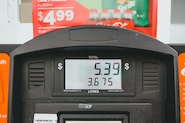
"I don’t understand why we’re happy with today’s lowering gas prices.
When gas prices surpassed the $4 a gallon mark earlier this summer, prices falling in to the $3.60 range make us believe we’re saving big bucks.
But, gas was under $2 a gallon just 2 years ago which is a buck and a half more than we’re paying today.
I have a theory that “they” wanted the gas price to be raised to $3 a gallon.
Rather than just take it to $3, let’s balloon it to $4+ and then let it slowly slide back.
We clever Americans will say, “Gas is down 50 cents a gallon” when it’s really $1.50 higher than where it used to be.
Also, for the last 25 years, we’ve had a Federal gas tax of 18.4 cents a gallon while the average state tax on a gallon of gas runs 32.4 cents a gallon.
That’s supposed to help pay for road repairs and upkeep.
How’s that been working?
I studied the history of gasoline prices in this copuntry and noted in 1931, we were shelling out 17 cents a gallon.
We also had that “Depression-thing” going on.
In 1948, it was 26 cents a gallon (on average) and then went to 53 cents a gallon in 1974, after the OPEC oil embargo in 19783.
In 1980, gas surpassed the dollar a gallon plateau ($1.19) and we saw the first $2+ a gallon in 2005.
In 2011, we were subject to the first $3+ a gallon to fuel our cars.
But in each case of these price marks, we saw gas briefly higher than those we ended up at.
Gives credence to my theory that price spikes are meant to get us used to paying more per gallon.
You always here about “supply and demand” being the driver of gas prices.
Recently, prices started falling as people drove less so the price per gallon started to slide downward.
Brings me to another observation.
Gas prices always rise faster than they decline.
I think those initial price jumps are intended to be like splashes of cold water in our faces that will eventually result in smiles on the faces of consumers when gas prices slide.
It’s all connected to modern day economics.
Some of the gas price is tied to inflation.
By definition, that’s a general increase in the price of good and services.
When prices rise, your money buys less and your actual purchasing power is reduced.
So far this year, the CPI (Consumer Price Index) has increased 9.1%.
So, if you happened to get a $10 an hour pay raise, you can actually only afford a dollars’ more worth of goods.
Plus, you’ll be in a higher tax bracket.
There’s a big discussion today about a “recession”.
Some say we’re experiencing one; others say no.
By historical definition, a recession is “a period of temporary economic decline during which trade and industrial activity are reduced”.
A recession is generally identified by a fall in the GDP (Gross Domestic Product) in 2 successive quarters.
It’s normally visible in real GDP, real income, employment, industrial production, as well as wholesale and retail prices./
The economy slows down, businesses produce less, consumer spending declines.
This can result in layoffs as businesses try to reduce costs in response to a significant decline in demand for goods and services.
What muddies the water for me is this entire COVID experience when we pretty much went into “sleep mode” economically.
It wasn’t all that long ago that everybody was making masks, hand sanitizer and disinfectant sprays.
I have found that the only people worse at predicting outcomes than sportscasters are economic experts.
Early forecasts by some of these wizards said we’d only see a “slowing” of economic growth.
Bank of American has since followed an early forecast of Japanese investment banker Nomura by saying we’ll experience a “mild recession” for the rest of 2022, spilling into the 1st quarter of 2023.
Care to wager any money on that right now?
Typically since World Wart II, recessions have lasted 6 to 12 months although the “Great Recession of 2008” dragged on for 18 months.
So why are we or are we not in a recession?
Venture capitalist and host of tv’s “Shark Tank”, Kevin O’Leary states all of our problems are related to the fact that “our government just printed too much money” in response to COVID and various relief efforts.
The “Truth in Accounting” website says each American taxpayer’s share of our national debt exceeds $900,000.
Our U.S. government currently has about $6 trillion in assets while we owe over $129 trillion to Medicare, Social Security and other areas.
I found another website that states the national debt is closer to $30 trillion.
Seems to me, we can’t “cover” either figure.
Individual and income taxes make up 86% of what our Federal government collects from the roughly 114 million taxpayers in our country.
And now, the IRS is going to be beefed up to go after tax evaders.
Can you say “blood from a turnip?”
Maybe we need a lot of people with needles to take the air out of inflation instead.
How long will it be before I need my truck full of money just to get a fill-up?"
Read the full article on: Johnny on the Spot

